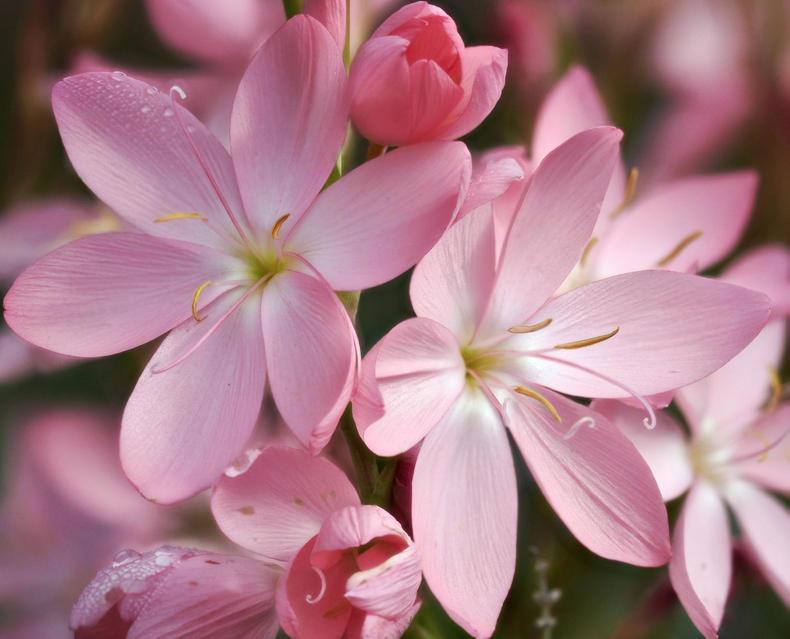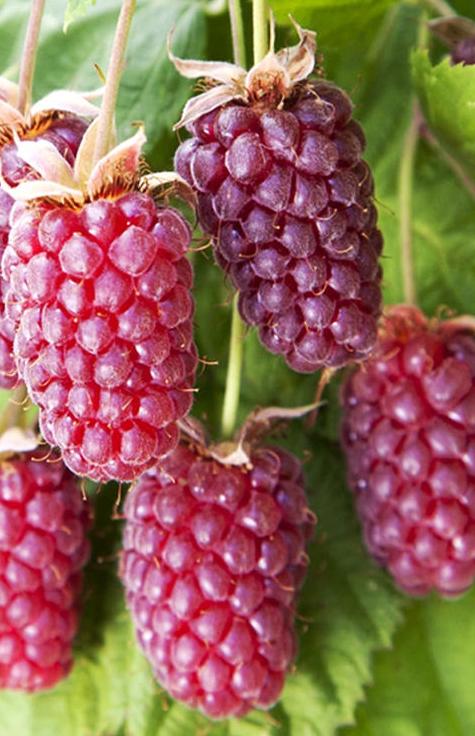Also known as fire lily, flag lily or kaffir lily, river lily flowers for several weeks in October and November and even later if the weather does not turn nasty. The most commonly grown kind is ‘Mrs Hegarty’, a pale pink form. This is a vigorous variety that makes a low clump with relatively short-stemmed flowers. Other varieties include the well-named ‘November Cheer’ with tall stems and pink flowers and ‘Major’ which is also tall and has bright red flowers. The two larger plants do not colonise as well as the smaller variety, except in good conditions and, being taller, the stems tend to blow over more easily.

Hesperantha 'Jennifer'.
‘Sunrise’ is also quite tall with large pink flowers to five centimetres across in autumn. Some are earlier to flower, such as ‘Jennifer’ which flowers in early autumn. ‘Viscountess Byng’ is similar to ‘Mrs Hegarty’ but flowers very late in autumn and into early winter. It sometimes gets hit badly by hard frosts. A light frost does not greatly bother the flowers which simply close and open if the sun comes out, but severe frost can desiccate the petals. Luckily, there is a succession of flower buds that open in sequence and even if one set is damaged another will be following on.
Although native to mountain pastures in parts of South Africa, the damp climate and soils here seem to suit it very well
The divided style at the centre of the flower has given the plant its previously correct botanical name, Schizostylis, which means ‘split-style’. It is divided in three and there are three male stamens with blue anthers that make a remarkable contrast with the pink or red flowers. That name has been superseded and the correct botanical name now is Hesperantha, which means evening flower. Although native to mountain pastures in parts of South Africa, the damp climate and soils here seem to suit it very well and it thrives in most gardens. It appears by streamsides and in damp pasture in its native land but while it likes moist soil, it does not like to be water-logged. If grown in soil that dries out in summer, the foliage tends to wither away and the plant is severely weakened.
Although it might sound tricky to grow, it is not and it thrives in ordinary garden soil. The ideal is a humusy soil or a silty soil that can hold moisture without waterlogging, not a heavy clay soil that tends to dry hard in summer.
Division in spring is a good way to increase the number of plants and to rejuvenate old clumps
Use garden compost or leaf mould, scattered over the plant or a light shake of general fertiliser every few years to established clumps that have become congested and do not flower well. Division in spring is a good way to increase the number of plants and to rejuvenate old clumps. This does not have to be done very often, every five or seven years is enough.
Although the foliage and stems are light, it fills the root area with roots and rhizomes, making a tight clump and not allowing weeds to get much chance to thrive. The leaves and stems also tend to flop forward over competing weeds and because the foliage is evergreen, it puts pressure on weeds. Although evergreen, the foliage does suffer quite a bit in winter and usually will have died back halfway or more by springtime. Frost and cold wet weather can cause this die-back. The plant is not completely hardy and can be killed in the coldest parts of the country but does fine in most areas. The clumps can look a bit miserable by spring time but soon the new foliage begins to grow and pushes out past the old withering leaves.

Loganberry.
Loganberry is a raspberry hybrid that has been around for more than a century, which was first developed in California. It is an excellent garden fruit because it has a long-fruiting period, from late July onwards. It can produce fruit late into autumn as it did this year. The fruit is quite tart to taste, unless very ripe and even then it has a bite, but its fruity taste is very rich. It is good for jam making.
It is a big grower, well capable of throwing out three-metre shoots
Also, it is very adaptable and easy to grow. Loganberry will cope with even a shady wall, though it will not fruit as well. The plant is gangly and has to be trained to a wall or fence or supported by posts and wires. It is a big grower, well capable of throwing out three-metre shoots, but these are flexible and easily tied back. Prune out the old shoots now and tie new ones. And if you have a place for a loganberry or a tayberry, its modern equivalent from Scotland and as good is not even better, it can be planted now.
Trees, shrubs and roses
Deciduous hedges such as beech can be clipped if this was not done earlier. Tree planting must be put on hold if the ground is very wet. It is twice the work if the ground is sticky and it is a bad start for plants. Rose bushes can be pruned and climbing kinds too and the shoots tied into position.
Lawn
The leaves are coming down and if they are lying on lawn areas, they must be raked off and blown or brushed off a driveway or patio. Do not mow or walk over the lawn surface when it is wet, but there will be occasional spells of dry weather when the ground will firm up enough to carry out mowing.
Flowers
If the ground is wet, do not undertake herbaceous perennial division and replanting. Many flowers react very badly to being moved into cold, wet ground, particularly grasses. But division of existing plants, especially spring-flowering kinds and planting of new kinds can continue in good conditions.
Fruit, vegetables and herbs
Fruit tree pruning can be carried out, except on plums. Fruit trees and bushes can be planted in good conditions. For best results, choose a place with good deep soil, full sunshine and good shelter. Tidy away rubbish and control weeds. Mix half the volume of leaves with garden compost for a more rapid composting.
Greenhouse and house plants
Good light is important for house plants to keep them looking well. Give the best light to flowering house plants because the foliage kinds can cope with less. In the greenhouse, set up a frost protection heater to prevent frost damage if there are tender plants.
Also known as fire lily, flag lily or kaffir lily, river lily flowers for several weeks in October and November and even later if the weather does not turn nasty. The most commonly grown kind is ‘Mrs Hegarty’, a pale pink form. This is a vigorous variety that makes a low clump with relatively short-stemmed flowers. Other varieties include the well-named ‘November Cheer’ with tall stems and pink flowers and ‘Major’ which is also tall and has bright red flowers. The two larger plants do not colonise as well as the smaller variety, except in good conditions and, being taller, the stems tend to blow over more easily.

Hesperantha 'Jennifer'.
‘Sunrise’ is also quite tall with large pink flowers to five centimetres across in autumn. Some are earlier to flower, such as ‘Jennifer’ which flowers in early autumn. ‘Viscountess Byng’ is similar to ‘Mrs Hegarty’ but flowers very late in autumn and into early winter. It sometimes gets hit badly by hard frosts. A light frost does not greatly bother the flowers which simply close and open if the sun comes out, but severe frost can desiccate the petals. Luckily, there is a succession of flower buds that open in sequence and even if one set is damaged another will be following on.
Although native to mountain pastures in parts of South Africa, the damp climate and soils here seem to suit it very well
The divided style at the centre of the flower has given the plant its previously correct botanical name, Schizostylis, which means ‘split-style’. It is divided in three and there are three male stamens with blue anthers that make a remarkable contrast with the pink or red flowers. That name has been superseded and the correct botanical name now is Hesperantha, which means evening flower. Although native to mountain pastures in parts of South Africa, the damp climate and soils here seem to suit it very well and it thrives in most gardens. It appears by streamsides and in damp pasture in its native land but while it likes moist soil, it does not like to be water-logged. If grown in soil that dries out in summer, the foliage tends to wither away and the plant is severely weakened.
Although it might sound tricky to grow, it is not and it thrives in ordinary garden soil. The ideal is a humusy soil or a silty soil that can hold moisture without waterlogging, not a heavy clay soil that tends to dry hard in summer.
Division in spring is a good way to increase the number of plants and to rejuvenate old clumps
Use garden compost or leaf mould, scattered over the plant or a light shake of general fertiliser every few years to established clumps that have become congested and do not flower well. Division in spring is a good way to increase the number of plants and to rejuvenate old clumps. This does not have to be done very often, every five or seven years is enough.
Although the foliage and stems are light, it fills the root area with roots and rhizomes, making a tight clump and not allowing weeds to get much chance to thrive. The leaves and stems also tend to flop forward over competing weeds and because the foliage is evergreen, it puts pressure on weeds. Although evergreen, the foliage does suffer quite a bit in winter and usually will have died back halfway or more by springtime. Frost and cold wet weather can cause this die-back. The plant is not completely hardy and can be killed in the coldest parts of the country but does fine in most areas. The clumps can look a bit miserable by spring time but soon the new foliage begins to grow and pushes out past the old withering leaves.

Loganberry.
Loganberry is a raspberry hybrid that has been around for more than a century, which was first developed in California. It is an excellent garden fruit because it has a long-fruiting period, from late July onwards. It can produce fruit late into autumn as it did this year. The fruit is quite tart to taste, unless very ripe and even then it has a bite, but its fruity taste is very rich. It is good for jam making.
It is a big grower, well capable of throwing out three-metre shoots
Also, it is very adaptable and easy to grow. Loganberry will cope with even a shady wall, though it will not fruit as well. The plant is gangly and has to be trained to a wall or fence or supported by posts and wires. It is a big grower, well capable of throwing out three-metre shoots, but these are flexible and easily tied back. Prune out the old shoots now and tie new ones. And if you have a place for a loganberry or a tayberry, its modern equivalent from Scotland and as good is not even better, it can be planted now.
Trees, shrubs and roses
Deciduous hedges such as beech can be clipped if this was not done earlier. Tree planting must be put on hold if the ground is very wet. It is twice the work if the ground is sticky and it is a bad start for plants. Rose bushes can be pruned and climbing kinds too and the shoots tied into position.
Lawn
The leaves are coming down and if they are lying on lawn areas, they must be raked off and blown or brushed off a driveway or patio. Do not mow or walk over the lawn surface when it is wet, but there will be occasional spells of dry weather when the ground will firm up enough to carry out mowing.
Flowers
If the ground is wet, do not undertake herbaceous perennial division and replanting. Many flowers react very badly to being moved into cold, wet ground, particularly grasses. But division of existing plants, especially spring-flowering kinds and planting of new kinds can continue in good conditions.
Fruit, vegetables and herbs
Fruit tree pruning can be carried out, except on plums. Fruit trees and bushes can be planted in good conditions. For best results, choose a place with good deep soil, full sunshine and good shelter. Tidy away rubbish and control weeds. Mix half the volume of leaves with garden compost for a more rapid composting.
Greenhouse and house plants
Good light is important for house plants to keep them looking well. Give the best light to flowering house plants because the foliage kinds can cope with less. In the greenhouse, set up a frost protection heater to prevent frost damage if there are tender plants.








 This is a subscriber-only article
This is a subscriber-only article





SHARING OPTIONS: